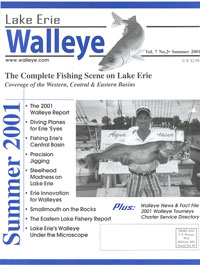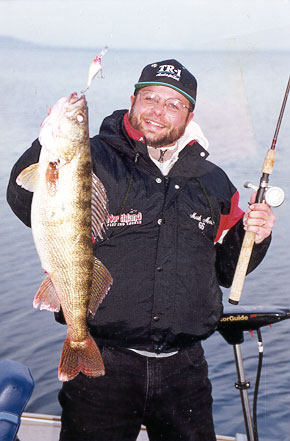Erie Innovation for
Walleyes
by Mark Martin

Order Lake Erie Walleye Magazine
Three Information-Packed Issues for only $10.00
Delivered to your doorstep every March, June and September
|
Erie Innovation for
Walleyes |
|
R
ight now, as hard-core trolling tactics are in full swing every place on Erie, Im armed with a selection of dependable lures that are excellent alternatives. For simplicityıs sake, and to offer a straightforward strategy for success, Iıve come up
with three of the most effective lure and bait styles that will do the trick
around the reefs and river mouths when the trolling bite isnt working out. Or
even if it is, these tips and tricks can serve as backup plans when the wind
blows or if youıre in a smaller boat without the full assortment of trolling
gear. Whenever youıre around walleyes, it pays to break out the jigs, body
baits and a dead rod. Now is the time to adapt them to Erie.
up
with three of the most effective lure and bait styles that will do the trick
around the reefs and river mouths when the trolling bite isnt working out. Or
even if it is, these tips and tricks can serve as backup plans when the wind
blows or if youıre in a smaller boat without the full assortment of trolling
gear. Whenever youıre around walleyes, it pays to break out the jigs, body
baits and a dead rod. Now is the time to adapt them to Erie.
Jigs
Of all the jigs on the market, none is more effective or versatile than the Northland Fire-Ball. They come in sizes from miniature to magnum, giving you the ability to cover all depths and drop speeds. And theyıre perfect for snap-jigging, vertical jigging in rivers and lakes, casting and dragging, any
way you want to fish them. Though they are round jigheads, they excel even in current because of the slight keel shape of the head, which makes them track straight in running water. Fire-Balls are large for their weight,too meaning a 1/16th-ounce specimen is bigger than a lot of regular 1/8th-ouncers, and have bigger, more dramatic profile fish like.
More than anything, the Fire-Ball is a live-bait jig, since it comes without a keeper collar to hold on plastics. I use them with minnows, leeches and half night crawlers. In springtime, I turn to a few tricks to catch more fish. When I know a bunch are beneath me, I often bait up with two small minnows, one hooked upside down, the other right side up. This gives you a pair of minnows in the shape of a V for a more enticing profile. And if
walleyes are striking short, if one does rob you of one of the minnows, it will often turn around and grab the remaining bait. Something to remember.Iıve seen the technique work time and again on the reefs of Erie's Western Basin. You might feel the first hit and miss, but often the same fish, or maybe a different one, will pounce on it harder the next time. For an added trick, every once in a while I hook a single minnow upside down. I do it
when Iım fishing very slowly and giving the jig little action; instead, I depend on the minnow to do it for me. Upside down, the minnow is prone to extra antics.Another jig from Northland that has an important place in my tackle box is the Whistler. It has a streamlined head and a small propeller for added sound and flash. If normally Iıd fish a 1/4-ounce round jig, I boost up to a 3/8ths with the Whistler because of the added lift you get with the propeller. Whistlers are great for casting the shallows, around creeks, rivers and shorelines. When I pitch it out, I often work it almost like a crankbait. When it gets to bottom, I lift it and stop, lift and stop, perhaps a little faster than with a standard jig. With a Whistler I like to turn to plastics as well. Since the Whistlers have a curvature to their hooks, theyıll hold plastics in place without tearing off. Try small tubes or Berkley Power Jigworms or Minnows. Sometimes I add an extra squirt of Berkley Walleye Scent. In case youıre having trouble keeping near bottom
with river current, try cutting the Whistlerıs prop off the jig. This way, youıll lose the lift of the propeller and have the keel-shaped head to slice water with better hydrodynamics.One of the more offbeat offerings depends on nothing but plasticin fact, itıs a double-barrel plastic presentation. On a standard jighead with a keeper to hold the plastic, I put a Berkley Power Minnow and then cut an inch or so off the back of the hook, as if I were tipping it with live bait.
This unusual combination is great in deep water and in times of poor boat control, when you can drag the fake baits over flats or the edge of structure.
Iıve extended the twin rigıs use to deep water, running a heavy jig where I might otherwise want to fish a crankbait but am unsure I can reach bottom in 30 feet and beyond.
Shad Raps
Ever since their debut in the ı80s, Rapalaıs Shad Raps have been catching fish of all species from coast to coast. For me, theyıre go-to baits in walleye country, especially in spring, when I start with a No. 5 in water six feet and less. Because you can work them faster than a jig, they help eliminate water, and suspended fish will come up several feet to strike
them. But I like them to tick and nick bottom on the way in. Now, I donıt exactly pound them off the bottom, but a little light touch of bottom is perfect. When you do feel it hit, stop it. Start it up again and when it ticks again, stop it.
Every now and then I will plow it into bottom just to see what happens. Sometimes itıs the ticket. If the waterıs a little deeper, go with the slightly larger No. 7.A new weapon in my arsenal is the Shad Rap RS, a rattling, suspending bait. Once, while doing a Bass Pro Shops seminar and casting into one of the fish tanks, I had walleyes, which, as we all know, ignore almost every bait or lure in such captivity, racing after the suspender. Like all crankbaits,
donıt just cast them out and reel them in. Rather, reel it down, tick bottom and pause. The lure will just hover there, not float up, and walleyes will grab it. Thereıs something about a lure stopping in a walleyeıs face that it canıt resist. You get much the same action when trolling them behind boards,
a prime technique for suspended fish on Erie. (Okay, I had to mention trolling on Erie.) As the board shoots forward and then stalls on a turn, the bait will sit there, and the walleyes nail it.
With either type of Shad Rap, I like to add a little extra flash with thin strips of Witchcraft holoform tape. I also experiment with the company's adhesive eyes you can stick to the bait. Sometimes it makes a difference. On certain waters, Iıve found the walleyes have a definite preference for yellow eyes and black pupils. I donıt know why, but I do know they work.But thereıs a lot more to a Shad Rap than just casting. Raps are excellent trolling baits, and I have the depths they track almost down to a science. Without weight and with Berkley 20-pound FireLine (the diameter of eight-pound monofilament), I can get a No. 5 down six feet with 63 to 73
feet of line, a No. 7 down seven to 10 feet with 100 to 110 feet of line, a No. 9 down nine, 10, even 12 or 13 feet with 140 to 150 feet of line.Trolling speed is important, and I almost always run 1 mph to 1.3 mph. If you do go faster, your lures are going to dig deeper. Try trolling Shad Raps around tight contours when you want to get a bait into small places on a short line or when you want to get out and over bottom on lake basins. They
also excel for trolling around river mouths, where you need a shorter line because of boat traffic or to get a bait into tight places.And, lest I forget, when casting add an extra rod, where legal, with live bait to pick up another fish or two or three. More on that in a moment.
The Dead Rod
A dead rod, or one thatıs basically unattended, will liven up the action
many days. When Iım moving along a contour jigging or tossing a Shad Rap, Iıll put another rod out with a Northland Rock-Runner bottom bouncer and a Northland Gum-Drop Floater with bait.For best results, I put a fast-action rod in a holder with a bouncer, a
leader up to three feet and a Gum-Drop in small, medium or large. If fish are tentative Iıll use a smaller one. If theyıre more active, Iıll boost up in size, or if Iım around bigger fish. The spongy material of the floater keeps the bait just above the tops of emergent weeds. It also helps to keep the bouncer a few inches from bottom. When you get a strike, the rod will start to bend; pick it up and set the hook.Any bait, a leech, crawler or minnow, will do the trick, but I prefer minnows around Erieıs big fish. Some Gum-Drops come with stinger hooks, but I donıt put the stinger into the bait. Since the stinger is tied on stiff mono, it
will lie right next to the minnow and help you nail short-strikers. Or, as happens with big, Great Lakesfed fish accustomed to inhaling high-profile baits, they might very well hold on and not let go. If only walleyes everywhere were that way.